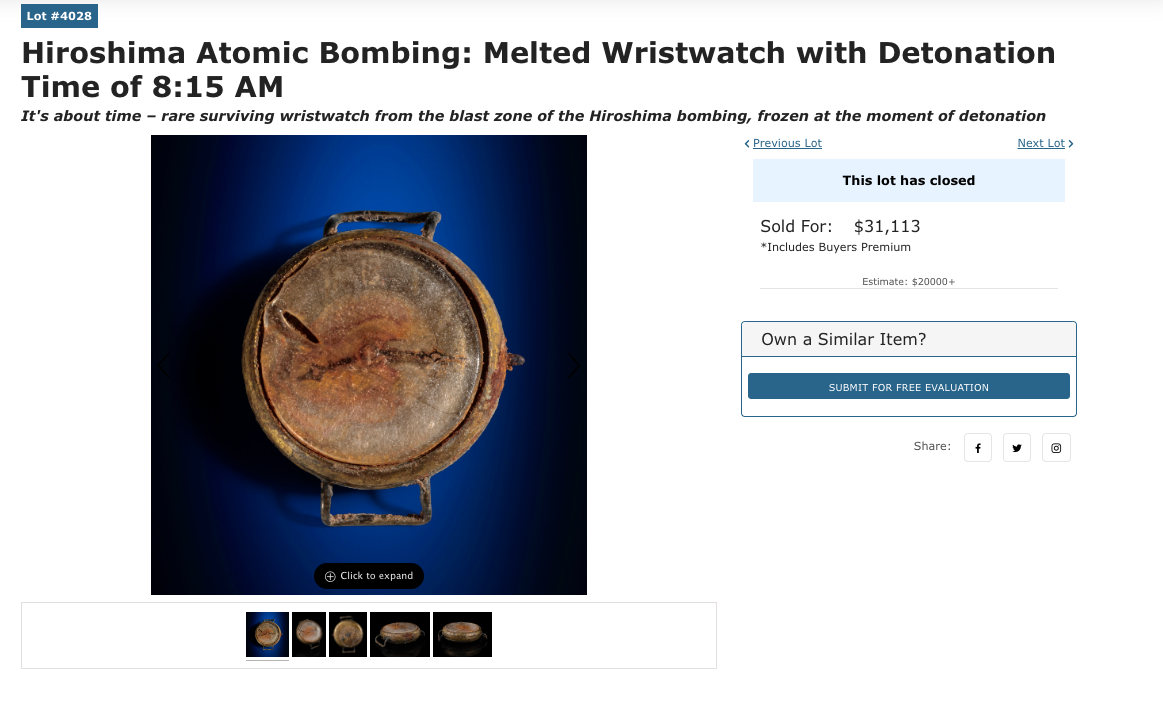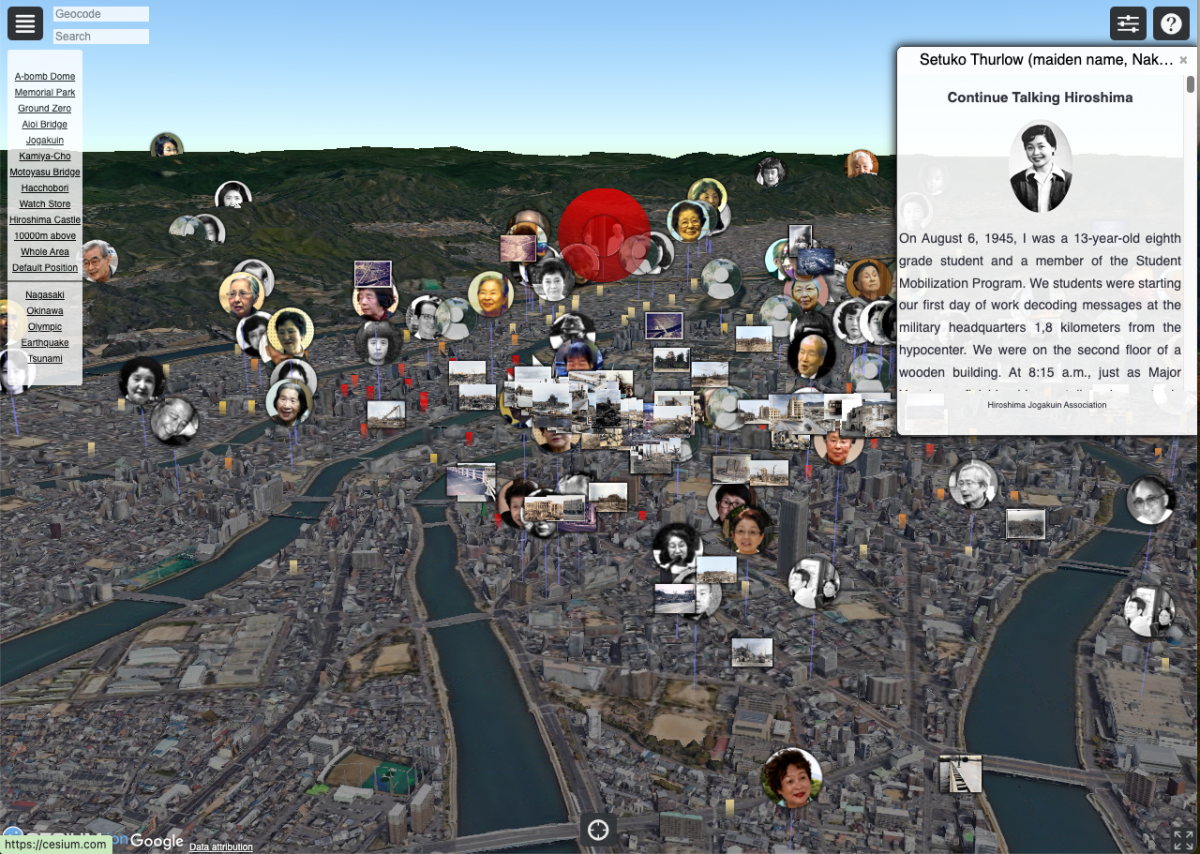A high school teacher in my hometown Hiroshima once shared with me a quote from David Krieger, “Some view Hiroshima from above mushroom clouds, whereas some are under the clouds.”
On the evening of Feb. 22, an auction titled “Hiroshima Atomic Bombing: Melted Wristwatch with Detonation Time of 8:15 AM” was concluded with a $31,113 winning bid.
Some, including sellers and bidders, perceived this auction as an opportunity to collect a rare historic treasure that symbolizes the dawn of the nuclear era. For other people, this watch is an artifact of a tragic memory. They felt disrespected, disgusted, horrified, and furious because they perceived this auction as an act of repeated humiliation to all victims and survivors. They imagine what happened to the owner; the catastrophic atomic explosion that froze the time of the watch; and the blast, heat, radiation, and trauma suffered by tens of thousands of innocent civilians.
The perception gap on the meaning of the watch auction highlights the importance of ongoing public education about the catastrophic humanitarian impacts of nuclear weapons. Without awareness and understanding of the human catastrophe, it is easy for us to treat past events as dull, esoteric history textbook contents. When people cannot associate the wristwatch with a tragic memory of Hiroshima, they begin treating it as merely a historic rarity. This auction reminds us that we must spare no effort to bring people’s understanding and view under the mushroom clouds.

The Auction and Reactions
The advertising pitch by RR Auction, an auction company based in Boston, put the headline describing the watch as follows: “It’s about time – rare surviving wristwatch from the blast zone of the Hiroshima bombing, frozen at the moment of detonation.”
The advertisers did not mention people in Hiroshima represented by the watch.
According to the auction website, the wristwatch was “recovered” by a British soldier who was stationed in Hiroshima to “provide emergency supplies and survey post-conflict reconstruction requirements while at the prefectural Promotion Hall,” which is now well known as “A-bomb Dome.” Later in 2015, “an anonymous collector offered it for sale” at another auction house in England, and then the watch was “purchased and eventually sold to the consignor” of this latest auction.
The Hiroshima Peace Memorial Park Museum did not make an official comment responding to the auction, as they could not verify that this watch was exposed to the bombing in Hiroshima, according to Hiroshima Home Television.
“It is unforgivable that horrors of the atomic bombing seem to be used as a tool for profiteering,” noted Toshiyuki Mimaki, a chairperson of the Japan Confederation of A- and H-Bomb Sufferers’ Organization who spoke to Hiroshima’s Chugoku Newspaper Feb. 23.
The International Campaign to Abolish Nuclear Weapons (ICAN) called upon the public to join their collective action to send an email to the RR auction to remove the listing. “How can RR Auction justify trying to profit off something like this? The watch … belongs in a museum, or with any surviving family if they can be found,” ICAN criticized, adding that it is an action of “shameless profiting of this poignant testament to the catastrophic impact of nuclear weapons, and the lives lost in Hiroshima.”
8:15 a.m. Is Not a Mere Symbol
The time 8:15 a.m. has become a symbol of the historical event, however, for those who are affected and care about nuclear weapons, it is not merely a symbolic time. To this day, the suffering of the victims, tens of thousands of the injured, their families, and descendants continues. Moreover, the existing 12,500 nuclear weapons today continue to pose an existential danger to all human beings.
On Aug. 6, 1945, the United States dropped the first atomic bomb “Little Boy,” with power less than a fraction of most nuclear weapons of today, from a clear sky over Hiroshima. On the morning of a sunny Monday, people were preparing for school or work, and about to start a day. At 8:15 a.m. the bomb exploded, destroyed a lively city, and killed an estimated 140,000 people by the end of that year. In Nagasaki, more than 74,000 people were killed by a second U.S. atomic attack three days later.
A single primitive bomb turned the city into “a hell-like scene,” as Hiroshima and Nagasaki often describe. The city was on fire and being filled with sufferers where there was no human dignity at all. Many walked with their eyeballs in their hands, with their melted skin and flesh hanging from their arms, stuck with glass shards on their face and body, crying for help, water, family, and loved ones. Even those who were not affected by the blast or heat but came to look for their relatives were also exposed to the ionizing radiation, which caused both acute and long-lasting harm.
Thousands of survivors or their families walked around the ruined city to look for their loved one’s bodies or at least to find their belongings. Shigeru Orimen was a freshman at Second Hiroshima Prefectural middle school who died in the bombing. His mother found his scorched lunch box and water bottle under his burned, skeletal body, and donated them to the Hiroshima Peace Memorial Museum. It is displayed at the museum along with his picture and his story explaining that he had left home and was looking forward to eating lunch, but lunchtime never came.
What Allows Such an Auction to Happen?
Reflecting on the news of this auction and after feeling discomfort, the question that came to my mind was why do such events occur? What is the difference between those who take issue with making a profit from these objects and those who do not? Why do some people look at this watch as a rarity, while for others it evokes the painful past and feelings of grave regret? For a hint to answer this question, I have looked at a recent similar auction case.
In September 2023, another auction house, Christie’s, triggered a big controversy over the sale of a jewelry collection with ties to Nazi regime wealth, which led to the cancellation of the auction due to strong opposition and outrage from the public.
After the cancellation, holocaust survivor David Schaecter, president of the Holocaust Survivor Foundation USA, stated that “they [Christie’s] recognized the great pain additional sales of … jewelry would cause Holocaust survivors,” according to a Jewish Telegraphic Agency report.
At the Christie’s auction, it seems that some people took serious issue with the auction because they knew what had happened to the victims and affected communities, and therefore, considered making a profit from the human catastrophe as disrespectful to the victims. If the Christie’s auction was not acceptable for Holocaust victims, why is the Hiroshima wristwatch auction acceptable for Hiroshima and Nagasaki victims?
What those artifacts that involve historical injustice tell us, is that unless we are directly or indirectly affected by the event, or try to put ourselves into affected communities’ shoes, we easily treat those artifacts simply as rare historical items.
Under the Mushroom Clouds
While it is critical to try to stop auctioning for sale objects symbolizing human catastrophes, the RR auction of the Hiroshima watch reminds us that the memory of the bombings of Hiroshima and Nagasaki, is at risk of falling into obscurity.
To reverse the trend of fading memory and understanding, we must redouble our efforts to help more people see the reality under the atomic mushroom clouds. Many governments and international organizations have undertaken initiatives of disarmament education and have repeatedly reiterated in multilateral disarmament fora that the importance of learning about the catastrophic humanitarian consequences of nuclear weapons cannot be emphasized enough. Among the many ways to educate ourselves, listening to survivors’ testimonies plays a fundamental role in helping people to imagine themselves on that sunny Monday morning at 8:15 a.m.
People in Hiroshima and Nagasaki have been concerned about the question of how to preserve the voices of survivors, and for those who inherit the tragic memory how to ensure the memory survives. In this era of events like the auction, their efforts deserve special attention and tribute. There are a number of projects to archive testimony and events through various forms of media, to name a few: Online testimonies on Google Earth, Hiroshima Archive and Nagasaki Archive, by Dr. Hidenori Watanave; A documentary film about Hiroshima survivor Setsuko Thurlow, the Vow from Hiroshima, by Susan Strickler and Mitchie Takeuchi; A magazine featuring survivors, Hiroshima: Faces, by ANT-Hiroshima; and a project using AI technology to color photographs of survivors, Rebooting Memories, by Anju Niwata. Those tools allow many of us, including policymakers and experts on nuclear issues, to bring our eyes under the mushroom clouds and to realize what is at stake.

Meanwhile, we must realize that this is not just a question that the people of Hiroshima and Nagasaki, and nuclear-weapons-affected communities must tackle, but others too. On the second International Day for Disarmament and Non-Proliferation Awareness, I would like to stress that “How do we preserve the memory of the catastrophic humanitarian impacts without leaving the victims’ stories behind?” is a question that we all must consider as long as nuclear weapons exist in the world.
Lastly, I would like to imagine that the person who won the auction will donate this watch to a museum for all the world to see the horrors of nuclear weapons. While I do not know if that will happen, I invite the bidders, the RR auction house, and all people involved in making a profit out of this wristwatch, to extend their imagination to ponder who was wearing it, how the watch was obtained, and the pain of the affected communities.
